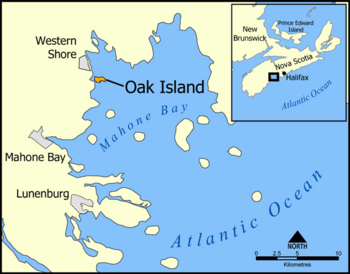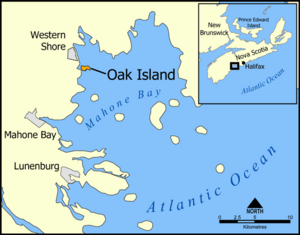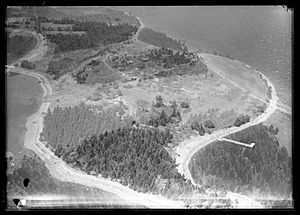Oak Island facts for kids

Island and Wharf, 1931
|
|
 |
|
| Geography | |
|---|---|
| Location | Nova Scotia, Canada |
| Coordinates | 44°30′49″N 64°17′38″W / 44.5135°N 64.2939°W |
| Total islands | 1 |
| Area | 57 ha (140 acres) |
| Highest elevation | 11 m (36 ft) |
| Administration | |
|
Canada
|
|
| Province | Nova Scotia |
| Demographics | |
| Population | Seasonal |
Oak Island is a small island in Nova Scotia, Canada. It covers about 57-hectare (140-acre) and is privately owned. The island is covered in trees and is one of about 360 islands in Mahone Bay. It rises to about 11 metres (36 feet) above the sea.
Oak Island is only 200 metres (660 feet) from the mainland. A special road called a causeway connects it to the shore. The island is famous for many stories about possible buried treasure or old artifacts. People have been exploring it for a long time to find these hidden items.
Island Geography and Nature
What is the climate like on Oak Island?
Nova Scotia, where Oak Island is located, has a climate with warm, humid summers. Winters are cold. There isn't a weather station right on Oak Island. However, nearby towns like Bridgewater give us an idea.
The average yearly temperature in Bridgewater is about 7.1 °C (44.8 °F). The area gets a lot of rain, around 1,536.7 millimetres (60.50 in) each year. The ocean can make Oak Island foggy, sometimes for up to 90 days a year. Strong storms, like nor'easters and hurricanes, can also hit the coast.
What animals and plants live on Oak Island?
Oak Island is covered in a type of forest called a temperate broadleaf and mixed forest. This forest is part of the larger New England/Acadian forests region.
Many interesting animals live around Mahone Bay. You might see great blue herons, black guillemots, and osprey. Other birds like Leach's storm petrels and razorbills also live there. Some eagles and puffins have been seen too. A special bird, the Roseate tern, is an endangered species in this area. The Canadian government works to protect it and its home.
How was Oak Island formed?
The land on Oak Island was first studied in 1924. Scientists found that the island is made of four drumlins. Drumlin are "elongated hills" made from many layers of rock and soil. These layers were left behind by glaciers over the past 75,000 years.
The layers on top of the solid rock are mostly made of a type of clay called "Lawrencetown" till. This till is a mix of sand, silt, and clay. Underneath Oak Island, there are two types of solid rock. One part has limestone and gypsum. The other part has slate. Thousands of years ago, Oak Island and Mahone Bay were a lagoon. The sea level rose as glaciers melted, changing the area.
Human History of Oak Island
Who lived on Oak Island first?
The first major group of people in Nova Scotia were the Mi'kmaq. They formed a nation in Canada thousands of years ago. The area around Oak Island was known as "Segepenegatig" to them. While we don't know exactly when Oak Island was first found, the Mi'kmaq lived all over this region.
The first Europeans known to live nearby were French fishermen in the 1750s. They built houses near what is now Chester, Nova Scotia. After the Seven Years' War, the British government wanted more people to settle in Nova Scotia. They offered land to settlers from New England in 1759.
How did Oak Island get its name?
The first main group of settlers arrived in the Chester area in 1761. Oak Island was surveyed and divided into 32 lots in 1762. Families like the Monro, Lynch, Seacombe, and Young families owned much of the island.
In the early days of British settlement, the island was called "Smith's Island" after an early settler named Edward Smith. Later, in 1778, a mapmaker named Joseph Frederick Wallet DesBarres renamed it "Gloucester Isle." Soon after, the local name "Oak Island" became the official name. Edward Smith and Anthony Vaughn Sr. were some of the early residents.
Who owns Oak Island today?
Oak Island has been owned by many different people who were looking for treasure. This started after early settler stories appeared in the late 1700s. The search for treasure became so big that in 1965, a causeway was built. This road connected the island to the mainland, allowing heavy machines to be brought onto the island.
More recently, a treasure hunter named Dan Blankenship owned the island with a group called the "Michigan Group." This group includes brothers Rick and Marty Lagina. Dan Blankenship passed away in 2019. Oak Island is lived on seasonally, with a few homes and cottages. Even though it's private property, you can visit by scheduling tours.
The Oak Island Mystery
What is the Oak Island Mystery?
Oak Island has been a focus for treasure hunters since the late 1700s. Rumors say that famous pirate Captain Kidd buried his treasure there. There isn't much proof about the earliest digs, but stories began to be published in 1856.
Since then, many theories have come up. Some believe the island holds religious artifacts, old writings, or even Marie Antoinette's jewels. However, some people think the search areas are just natural formations, not signs of treasure.
Where do people search for treasure on Oak Island?
There are a few main spots on the island where treasure hunters focus:
- The Money Pit: This is said to be the original search spot. It's on the east side of Oak Island. The Money Pit is believed to be a shaft more than 100 feet deep. According to island stories, a teenager found an indentation in the ground in 1795. He and his friends started digging and found a man-made shaft with wooden platforms every 10 feet down to 90 feet deep.
- Nolan's Cross: This is a pattern of large rocks named after a treasure hunter who had a theory about it.
- The Triangle-Shaped Swamp: This is another area of interest.
- Smith's Cove: This is a beach where searchers have found various items. These include coconut fibre, which is not native to the island. More recent finds in Smith's Cove include a lead cross, possibly from before the 15th century, and old wooden structures.
What books and TV shows are about Oak Island?
More than fifty books have been written about Oak Island's history and the different theories. Several fictional stories have also been based on the Money Pit. These include The Money Pit Mystery, Riptide, and The Hand of Robin Squires.
In 2014, the History Channel started a reality TV show called The Curse of Oak Island. This show follows a group of modern treasure hunters, including brothers Rick and Marty Lagina. The series has shown finds like old coins, an antique brooch, and a lead cross that might be from between 1200 and 1600 A.D.
See also
In Spanish: Isla del Roble para niños



